The aesthetics of subtraction ~ Absolute difference and the beauty of nature~
Yoshie Doi
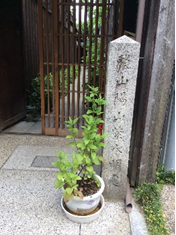 Entrance to Sanshisuimeisho |
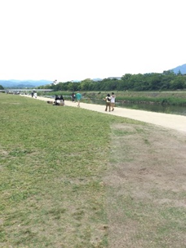 Kamogawa riverbank east of Sanshisuimeisho |
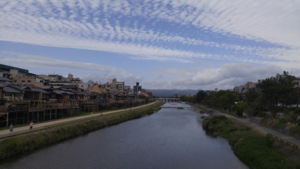 Photographed on October 5, 2023 |
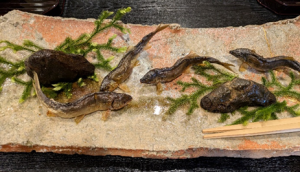 |
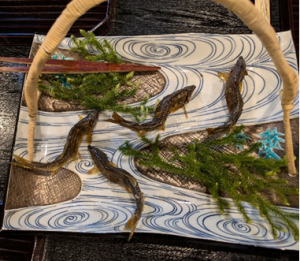 |
“Wagokoro Izumi” presents sweetfish as if they are swimming. Photographed on July 3, 2024
The most well-known word used to describe Kyoto is “Sanshisuimei.” Kyoto is often referred to as “Kyoto of Sanshisuimei.” Sanshisuimei refers to the study and teahouse called “Sanshisuimeidokoro” that Rai Sanyo built in Sanbongi on the Kamo River, where he died, after moving six times in the nine years since he entered Kyoto in the late Edo period.
Rai Sanyo coined the phrase “Sanshisuimei” (beautiful mountains and rivers) when looking east from the Kamo River, and the mountains turning purple refers to the time when the sunset is taking place. Today, it is used as an adjective, but it first appeared when Rai Sanyo wrote a letter saying, “Please come when the mountains and rivers are beautiful.
The time varies slightly depending on the season, but it is usually around 4pm. The water surface sparkles in the light of the setting sun, and the Higashiyama area is dyed a pale purple. This is called Sanshi Suimei. The Kamo River is beautiful at this time of day.
Kyoto culture and the city of Kyoto, which were created through the charm of nature and the accumulation of history, have an “absolute difference” that only Kyoto can have. Relative differences are differences that can be overcome, but absolute differences are differences that cannot be overcome. The aesthetics of subtraction are based on this absolute difference, and the process of subtracting to leave only the essence.
The presentation of food is also different from other places, and in Kyoto, the portions are small. The unnecessary is removed to leave only the essence. The aesthetic of subtraction can be seen in both dining and lodging. Is it a matter of refinement? In human relationships and in neighborhood relationships, while maintaining a moderate distance, Machigumi has a history of supporting each other more than relatives when it comes to important matters.
I’ve always thought that Kyoto is a city of minimalist aesthetics. I read a book yesterday about how America evaluated Kyoto before the end of World War II.
In 1945, the minutes of the American Atomic Bomb Target Selection Committee, which discussed which city to drop the atomic bomb on in Japan (dated May 12, 1945), outline the meeting as follows: “Kyoto, an industrial city with a population of 1 million. Former capital of Japan, many people and industries have migrated to Kyoto as other areas have been destroyed. Psychologically, Kyoto is the intellectual center of Japan, so small arms are better.” (Memorandum from Major J.A. Derry and Dr. N.F. Ramsay to General L.R. Groves)
Kyoto is considered the intellectual center of Japan. That is the role that Kyoto plays. Everything in Kyoto, from art, traditional industries, traditional architecture, temples and shrines, universities, modern architecture, festivals, food, tableware, presentation, clothing, and interior decor, is artistic.
Furthermore, “Japan 1852,” a book that served as the basic material for Commodore Perry’s expedition plan and which he is said to have read on his ship before arriving in Japan during his visit at the end of the Edo period, describes Kyoto as follows: “The capital (Kyoto) is the city where the holy emperor resides…It is agreed that Kyoto is like a city of immorality and profligacy…This city is also the center of various industries. Many products are made with the quest for perfection. It is also a city of science and literature.”
This is an interesting review of Kyoto in the Edo period. There was a culture of pursuing perfection while engaging in what could be considered wasteful spending. This spirit made Kyoto culture, traditional industries, and ventures the best in the world.
How happy would we be if we could eliminate the unnecessary and focus only on what we love, just like the aesthetic of subtraction in life? Kyoto’s history is fascinating.
The end of document
Translated by Masami Otani
